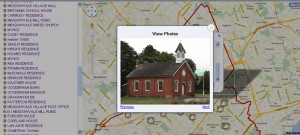
Have you ever wondered where you can find a bookstore, photography studio, or theatre in Mississauga? Or perhaps attend an event, visit a historic site, or meet at a place of religious assembly? Or are you an independent artist and would like others to know where to find you?
This is the question Mississauga residents, tourists, youth, artists, and culture stakeholders find themselves asking. How can we find out how many arts and culture industries, organizations, facilities, and events Mississauga hosts? Why does this question pose a challenge and why does Mississauga need a focussed and innovative project to meet this challenge?
Well, Mississauga is the sixth-largest Canadian city, and one that is culturally diverse; more than half of its residents are born outside of Canada. Heritage Mississauga documents that the city used to be a congregation of villages with unique histories. These villages are now the communities of Clarkson, Cooksville, Dixie, Erindale, Malton, Meadowvale, Port Credit, and Streetsville.
“In Mississauga, it becomes especially important to take culture seriously in order to increase community participation, expression, and integration,” John Ariyo, the project manager of the Mississauga Cultural Resource Map, explains in an interview. “Culture is an area to make an effort. Culture needs to be planned.”
On June 10, 2009, Mississauga City Council approved its first Culture Master Plan for the city. One of the 44 recommendations of the Culture Master Plan was a dedicated cultural mapping project. Over two years, the mapping project developed into an online database that defines, displays, and catalogues Mississauga’s identity and history through its cultural activity, assets, resources, and heritage information: the Mississauga Cultural Resource Map.
Last term, the City of Mississauga Culture Division requested student input and a group of UTM Communication, Culture, and Information Technology students volunteered to aid in the project. The students proposed research and recommendations on concept and visual guidelines. In the process, the CCIT group underwent experiential project management and teamwork related training.
“A higher level of thinking comes out of such collaboration and giving back to the community,” says Joseph Ferenbok, a CCIT lecturer and last term’s campus project facilitator. “The university has to give back to the society through innovation, experimentation, novel research, and social capital.”
This term, the CCIT students are continuing with the project via an additional partnership with OCADU students. A CCIT internship course is the medium of the current collaboration.
The UTM and OCADU students are to further aid in the final stage of the project before it is released to the public: the icon development stage. The team will be producing a library of icons that will enable users of the map to easily navigate through categories like performing arts companies and visual art schools.
Developing icons isn’t an easy task. It requires thinking about accessibility and how colours and symbols communicate messages. The real challenge is predicting how the diverse Mississauga community will perceive certain metaphors.
“One thing I’ve known for a long time is that students are very smart people,” John Ariyo reflects. “Students understand the project; they are excited about it and they are ready to help us move forward.”
The current CCIT internship is one of a kind with its unique set of goals and experiences.
“We are constantly looking for ways to involve students with real-life projects and experiences,” says Tracey Bowen, a CCIT lecturer and internship coordinator. “And this is the first time we’ve taken a group of students into a project that has implications outside of a classroom project.”
Ferenbok and Bowen believe that students can benefit from such on-campus industry-based experiences, learning theory and combining it with practice and experience. Internship involvement can allow students to network, see real-world projects develop, and prepare for work after graduation.
“As a graduating student, this internship is a real prep for the real world, because I can apply what I learned during my career at UTM into my own city’s project,” comments Niwaz Kaur Mann, a digital enterprise management specialist. “And I can proudly say that I am contributing to something significant while still in school.”
The internship is important to the students working on the project, and it’s just as important to the project manager.
“We need to connect with the leaders of tomorrow,” Ariyo adds. “We see the future of our city in the youth, and we feel that this internship is an opportunity for them to gain access into how the municipal government works and to help them participate in the city-building process.”
The public launch of the Cultural Resource Map project is set for May 1 under the “Mississauga Culture on the Map” portal.
The portal will use Google Map applications, including street view and directions, but with its own icons and considerations that are unique to Mississauga’s identity. One such feature is a direct connection to Mississauga Transit.
The portal will be a “one stop shop” directory with comprehensive details about each company, studio, school, tour, and artist. Users will be able to browse through organized categories and sub-categories of resources in order to easier navigate their search queries.
Currently, there are a number of other cities developing similar projects, including Brampton, Oakville, and Hamilton.
“In the long term, as many municipalities around us continue to develop similar projects, we hope we can all leverage our collective assets,” John Ariyo concludes.


